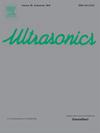用于高温超声传感的氧化铋硅的表征
IF 3.8
2区 物理与天体物理
Q1 ACOUSTICS
引用次数: 0
摘要
清洁能源生产作为国际优先事项继续增长。太阳能和核能发电厂被设计为在高温下运行,一些第四代核电站预计将在850摄氏度或更高的温度下运行。监测这种结构需要先进的传感器,能够在容易破坏传统传感器的环境中生存。铋硅氧化物(Bi12SiO20;BSO作为一种坚固的压电材料,可以在极端温度下生存,正受到人们的关注。在这项工作中,我们提出了高达600°C的BSO换能器的高温阻抗和相位表征。我们还利用5.1 × 5.1 × 1 mm3 BSO面剪换能器在3 mm厚的钢筋中产生准剪切水平波。我们在高达650°C的温度下进行了高温声传输和接收测试。在经历电容和介电损耗(在100 kHz测量)的大幅上升之前,BSO可以很好地保持其材料特性。BSO换能器也经历了发射频率从室温下的209-213 kHz到650℃下的约195 kHz的变化。当环境温度降低时,BSO能够恢复其材料性能,冷却测试表明,当样品冷却时,所有性能都恢复到正常范围。BSO还能够在室温至650°C范围内连续在结构钢上作为超声波发射器和接收器。此外,我们使用人工损伤进行了多次缺陷检测测试,BSO能够检测到高达600°C的损伤引起的波,误差≤10%。这些发现表明,BSO是一种具有耐久性和生存性的高温超声传感材料。本文章由计算机程序翻译,如有差异,请以英文原文为准。
Characterization of bismuth silicon oxide for high temperature ultrasound sensing
Clean energy production continues to grow as an international priority. Solar and nuclear power plants are being designed to operate at high temperatures, and some Generation IV nuclear plants are expected to operate at or above 850 °C. Monitoring of such structures requires advanced sensors able to survive in environments that would easily destroy conventional sensors. Bismuth Silicon Oxide (Bi12SiO20; BSO) is gaining attention as a robust piezoelectric material that can survive in extreme temperatures. In this work, we present a high temperature impedance and phase characterization of BSO transducers up to 600 °C. We also conducted experiments with 5.1 × 5.1 × 1 mm3 BSO face-shear transducers to generate quasi-shear horizontal waves in 3 mm thick steel bars. We performed high temperature acoustic transmission and receiving tests at temperatures up to 650 °C. BSO retains its material properties well until around 500 °C before experiencing major rises in capacitance and dielectric loss (measured at 100 kHz). The BSO transducers also experienced a shift in transmitting frequency from 209—213 kHz at room temperature to approximately 195 kHz at 650 °C. BSO was able to recover its material properties as environmental temperature decreased, and a cooldown test revealed that all properties returned to normal ranges when the sample was cooled. BSO was also able to perform continuously as an ultrasonic emitter and receiver on structural steel from room temperature to 650 °C. Additionally, we conducted multiple defect detection tests using an artificial damage, and BSO was able to detect damage-induced waves up to 600 °C with ≤10 % error. These findings suggest BSO is a material capable of performing high temperature ultrasonic sensing with durability and survivability.
求助全文
通过发布文献求助,成功后即可免费获取论文全文。
去求助
来源期刊

Ultrasonics
医学-核医学
CiteScore
7.60
自引率
19.00%
发文量
186
审稿时长
3.9 months
期刊介绍:
Ultrasonics is the only internationally established journal which covers the entire field of ultrasound research and technology and all its many applications. Ultrasonics contains a variety of sections to keep readers fully informed and up-to-date on the whole spectrum of research and development throughout the world. Ultrasonics publishes papers of exceptional quality and of relevance to both academia and industry. Manuscripts in which ultrasonics is a central issue and not simply an incidental tool or minor issue, are welcomed.
As well as top quality original research papers and review articles by world renowned experts, Ultrasonics also regularly features short communications, a calendar of forthcoming events and special issues dedicated to topical subjects.
 求助内容:
求助内容: 应助结果提醒方式:
应助结果提醒方式:


